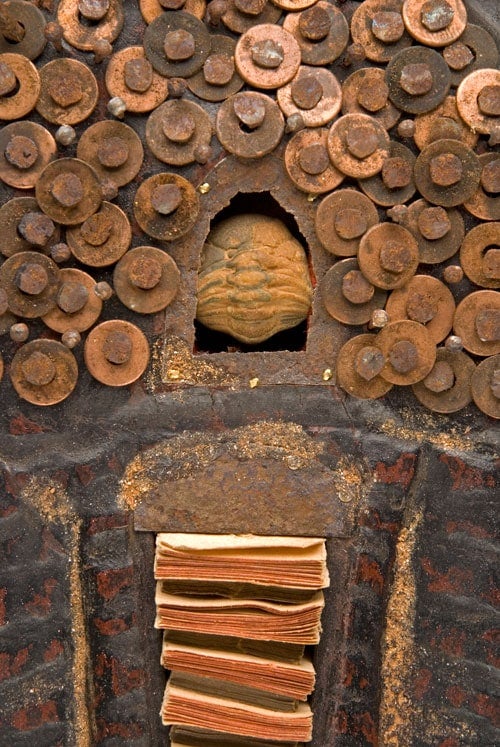
This winter, Lipscomb University’s John C. Hutcheson Gallery is hosting a new solo exhibition by Nashville-based artist Karen Seapker, who moved back to Tennessee in 2014 after a five-year stint in Brooklyn. In Nashville, she is represented by Zeitgeist Gallery and is a member of the local artist and curatorial collective COOP. This is Seapker’s first solo show since 2014, when she exhibited her work at Zeitgeist in a show titled “Re:Surface.” This body of work continues many of Seapker’s long-running themes while diverging in unpredictable and refreshing ways.
With her signature gradients, organic brushstrokes, and balled up fists of color, the new paintings are markedly more playful and lighthearted. At times there’s an almost cartoonish approach to the figure, like the comical hairy leg in Congregate (2016). At the bottom of Cradle (2016), we see a flattened figure that looks like something out of Looney Tunes. While it could be easy for these little hints of play to seem gimmicky or corny, they don’t. Instead, they add sense of balance and levity to her work that her earlier paintings often lacked.

And it is the very notion of balance that seems to be a central focus in this work. Not only formal and compositional balance—which is clearly considered—but also psychological balance. Coming off of a prior series of paintings depicting precariously, often impossibly, stacked rocks, this new work comes at the theme of balance from a entirely new angle. The idea of balance-as-comfort comes into play full force here. A new mother, Seapker ropes in themes of motherhood with unique subtlety, as she translates maternal desire and the palpable instinct to cradle, hold, and protect into a distinct visual vocabulary.
As for Seapker’s palette and her treatment of paint, it is utterly confectionary. It’s like looking in the window of a French pâtisserie. Smooth gradients and candy colors topped off with a perfectly silky glaze. Taking in her colors and general sense of surreality, I’m can’t help but think of John Divola’s Zuma series, circa 1977-78. The windows in both bodies of work seem to call to each across decades.

Seapker’s most successful works here are those that reference the figure. In a handful of paintings, she positions the human figure—often exaggerated, teased out, or hallucinatory—in the midst of indefinable chaos and beauty. The least successful are the smaller-scale, strictly abstract pieces, only because they are overshadowed by the intoxicating impact of larger works like Congregate and Harness (both 2016). When an artist’s work translates so well into the large-scale, as in Seapker’s case (though it isn’t the case for many painters), it’s hard not to ache for bigger and more monumental works. The smaller ones just seem to get lost, though in terms of potentially selling one’s work, it makes sense to paint in a variety of sizes.
As a life-long sucker for an enigmatic phrase, I was intrigued by the title. A quick Google search informed me that the title comes from a letter that the genius mathematician Ada Lovelace wrote to her mother in 1841:
“I must tell you what my opinion of my own mind and powers is exactly—the result of a most accurate study of myself with a view to my future plans during many months. I believe myself to possess a most singular combination of qualities exactly fitted to make me preeminently a discoverer of the hidden realities of nature. You will not mistake this assertion either for a wild enthusiasm or for the result of any disposition to self-exaltation. On the contrary, the belief has been forced upon me, and most slow have I been to admit it even.”
I asked Seapker about why she chose the phrase. She said she thought it was fitting in that Ada’s mother wanted to control her life, but Ada was uncontainable—and even went beyond the limits she had anticipated for herself.

“I love that letter as it explains her coming to terms with what feels like the mystical self-discovery of her greater destiny,” Seapker said. “I also just love the language and how those words fit together in this lovely—though maybe now seemingly unnatural—way.”
The phrase points to Seapker’s own feelings about her development as a painter. She said she can see so many possibilities for her work, yet she always thinks she’ll never have enough time to do it all. And while she may not feel like she can do it all, this exhibition is nothing short of a stellar achievement.
“And Most Slow Have I Been” is on view at Lipscomb University’s John C. Hutcheson Gallery through December 2.
Sara Estes is a writer and curator based in Nashville. She is the lead visual art writer at The Tennessean and an editor at Number, an independent arts journal of the South. She was a cofounder of the gallery Threesquared. Her writing has been featured in The Bitter Southerner, Nashville Scene, Nashville Arts Magazine, ArtsNash, ArtNow, and others. For more: saraestes.com.




